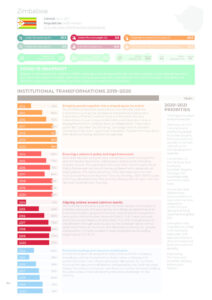Nutrition situation
Under five stunting (%)
23.5
Under five overweight (%)
2.5
Anaemia in women 15-49 years (%)
28.8
Under five wasting (%)
2.9
Low birth weight (%)
12.6
0 to 5-month-old exclusive breastfeeding (%)
41.9
Adolescent overweight (%)
Male: 6
/ Female: 21.7
Adult overweight (%)
Male: 22.2
/ Female: 52.8
Adult obesity (%)
Male: 4.7
/ Female: 25.3
Adult diabetes (%)
Male: 6.5
/ Female: 7.6
COVID-19 snapshot
Regular multi-stakeholder platform (MSP) meetings were disrupted initially but data collection and analysis resumed during the first quarter of 2020. SUN Networks have been actively involved with the nutrition cluster. Droughts, and restrictions due to the pandemic, have led to issues around food accessibility.
Institutional transformations 2019-2020
Bringing people together into a shared space for action
The SUN Networks have expanded in membership and use of platforms such as the Zimbabwe Vulnerability Assessment Committee (ZIMVAC) and the Food and Nutrition Security Committees, ensure ensure stakeholder participation in crucial engagements from national down to village levels. There was a youth-led ”Let’s Kick Out Stunting” campaign and 14 nutrition champions have been appointed. Members of parliament have been champions at raising nutrition on agendas.Ensuring a coherent policy and legal framework
Several landscape analyses were conducted around food systems and the food environment, adolescence and around emerging nutrition issues. The Agriculture Recovery Plan and the Agriculture Policy Framework are two of the key achievements, especially on food systems. The commissioning of the development of a new Multisectoral Food and Nutrition Security Strategy (2021–2025) is one of the key developments. This process is being done in sync with the National Development Strategy.Aligning actions around common results
The SUN Networks have used the Common Results Framework to mobilise resources, influence policy and design programmes and interventions; joint programmes have created greater integration among the United Nations Network (UNN), SUN Donor Network and Civil Society Alliance (ZCSOSUNA). The UNN strengthened its coordination through actions such as the Cohesion Series with a dedicated theme on Nutrition that identified pathways for greater collaboration. A matrix is used to track programmes, including responses to COVID-19.Financial tracking and resource mobilisation
A matrix has been developed to track actions of MSP members, including nutrition investment in dollar terms. Lobbying with parliamentarians has influenced budget allocations for nutrition. Much of the resource mobilisation conducted by the UNN has been largely focused on rural areas, and there is a need to increase funding for urban areas. Financial tracking remains a challenge for the country.2020-2021 Priorities
- Training on budget analysis exercise.
- Advocacy on N4G Commitments and for Food and Nutrition Security food and nutrition security to remain central within the development agenda.
- Completion of the Multisectoral Food and Nutrition Security Strategy with accompanying communication tools.
- Document and disseminate success stories on how communities adapted to COVID-19 and drought at local,regional and global fora.
- Strengthen the momentum of the SUN Networks, especially SUN Business Network drive for improved food and nutrition security.
- Enhancing the Food and Nutrition Security Information System.
Download

